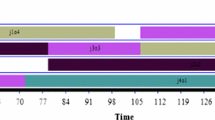Abstract
One of the economic production quantity problems that have been of interest to researchers is the production with reworking of the imperfect items including waste most disposal form and vending the units. The available models in the literature assumed that the decay rate of the items is satisfied from three different points of view: (i) minimum demands of the customer’s requirement, (ii) demands to be enhanced for lower selling price and (iii) demands of the customers who are motivated by the advertisement. The model is developed over a finite random planning horizon, which is assumed to follow the exponential distribution with known parameters. The model has been illustrated with a numerical example, whose parametric inputs are estimated from market survey. Here the model is optimized by using a population varying genetic algorithm.





Similar content being viewed by others
References
Ali, Sadia Samar, Madaan, J., Chan, F. T. S., & Kannan, S. (2013). Inventory management of perishable products: A time decay linked logistic approach. International Journal of Production Research, 51(13), 3864–3879.
Buzacott, J. A. (1975). Economic order quantities with inflation. Operational Research Quarterly, 26, 553–558.
Cardenas-Barron, L. E., & Sana, S. S. (2015). Multi-item EOQ inventory model for a two-layer supply chain when demand varies with a promotional effort. Applied Mathematical Modelling, 39(21), 6725–6737.
Chan, F. T. S., & Prakash, A. (2012). Inventory management in a lateral collaborative manufacturing supply chain: A simulation study. International Journal of Production Research, 50(16), 4670–4685.
Chan, F. T. S., Tibrewal, R. K., Prakash, A., & Tiwari, M. K. (2015). A biased random key genetic algorithm approach for inventory-based multi-item lot-sizing problem. Proceedings of The IMechE Part B: Journal of Engineering Manufacture, 229(1), 157–171.
Chan, F. T. S., & Wang, Z. (2014). Robust production control policy for a multiple machines and multiple product-types manufacturing system with inventory inaccuracy. International Journal of Production Research, 52(16), 4803–4819.
Das, D., Kar, M. B., Roy, A., & Kar, S. (2012). Two-warehouse production model for deteriorating inventory items with stock-dependent demand under inflation over a random planning horizon. Central European Journal of Operations Research, 20(2), 251–280.
Das, B., & Maiti, M. (2007). An application of bi-level newsboy problem in two substitutable items under capital cost. Applied Mathematics and Computation, 190(1), 410–422.
Dey, J. K., Kar, S., & Maiti, M. (2004). An EOQ model with fuzzy lead time over a finite time horizon under inflation and time value of money. Tamsui Oxford Journal of Management Sciences, 20, 57–77.
Dey, J. K., Mondal, S. K., & Maiti, M. (2008). Two storage inventory problem with dynamic demand and interval valued lead-time over finite time horizon under inflation and time-value of money. European Journal of Operational Research, 185, 170–194.
Dubois, D., & Prade, H. (1980). Fuzzy sets and system-theory and application. New York: Academic.
Goldberg, D. E. (1989). Genetic algorithms: Search, optimization and machine learning. Massachusetts: Addison Wesley.
Goyal, S. K., & Cardenas-Barron, L. E. (2002). Note on: Economic production quantity model for items with imperfect quality-a practical approach. International Journal of Production Economics, 77(1), 85–87.
Gumasta, K., Chan, F. T. S., & Tiwari, M. K. (2012). An incorporated inventory transport system with two types of customers for multiple perishable goods. International Journal of Production Economics, 139(2), 678–686.
Hosseini, S., & Al Khaled, A. (2014). A survey on the imperialist competitive algorithm metaheuristic: Implementation in engineering domain and directions for future research. Applied Soft Computing, 24, 1078–1094.
Hosseini, S., Al Khaled, A., & Vadlamani, S. (2014). Hybrid imperialist competitive algorithm, variable neighborhood search, and simulated annealing for dynamic facility layout problem. Neural Computing and Applications, 25(7–8), 1871–1885.
Jana, D. K., Das, B., & Maiti, M. (2014). Multi-item partial backlogging inventory models over random planning horizon in random fuzzy environment. Applied Soft Computing, 21, 12–27.
Khouja, M. (1995). The economic production lot size model under volume flexibility. Computers and Operations Research, 22, 515–525.
Khouja, M., & Mehrez, A. (1994). An economic production lot size model with imperfect quality and variable production rate. Journal of the Operational Research Society, 45(12), 1405–1417.
Kumar, V., Prakash, Tiwari, M. K., & Chan, F. T. S. (2006). Stochastic make-to-stock inventory deployment problem: an endosymbiotic psychoclonal algorithm based approach. International Journal of Production Research, 44(11), 2245–2263.
Last, M., & Eyal, S. (2005). A fuzzy-based lifetime extension of genetic algorithms. Fuzzy Sets and Systems, 149, 131–147.
Manna, A. K., Dey, J. K., & Mondal, S. K. (2014). Three-layer supply chain in an imperfect production inventory model with two storage facilities under fuzzy rough environment. Journal of Uncertainty Analysis and Applications, 2(17), 1–31. doi:10.1186/s40467-014-0017-1.
Michalewicz, Z. Genetic Algorithms + Data Structures= Evolution Programs. Springer(Indian) Private Ltd., (2009), Chapter 2 & 3.
Moattar, Husseini S. M., O’Brien, C., & Hosseini, S. T. (2006). A method to enhance volume flexibility in JIT production control. International Journal of Production Economics, 104(2), 653–665.
Moon, I., & Yun, W. (1993). An economic order quantity model with a random planning horizon. The Engineering Economist, 39, 77–86.
Roy, A., Maiti, M. K., Kar, S., & Maiti, M. (2009). An inventory model for a deteriorating item with displayed stock dependent demand under fuzzy inflation and time discounting over a random planning horizon. Applied Mathematical Modelling, 33, 744–759.
Salameh, M. K., & Jaber, M. Y. (2000). Economic production quantity model for items with imperfect quality. International Journal of Production Economics, 64, 59–64.
Sana, S., Gogal, S. K., & Chaudhuri, K. S. (2007b). On a volume flexible inventory model for items with an imperfect production system. International Journal of Operational Research, 2(1), 64–80.
Sana, S., Gogal, S. K., & Chaudhuri, K. S. (2007). An imperfect production Process in a volume flexible inventory model. International Journal of Production Economics, 105, 548–559.
Taleizadeh, A. A., & Nematollahi, M. (2014). An inventory control problem for deteriorating items with back-ordering and financial considerations. Applied Mathematical Modelling, 38(1), 93–109.
Wadhwa, S., Bibhushan, & Chan, F. T. S. (2009). Inventory performance of some supply chain inventory policies under impulse demands. International Journal of Production Research, 47(12), 3307–3332.
Wang, Z., & Chan, F. T. S. (2015). A robust replenishment and production control policy for a single-stage production/inventory system with inventory inaccuracy. IEEE Transactions on Systems, Man, and Cybernetics: Part A-Systems, 45(2), 326–337.
Yang, H.-L., Teng, J.-T., & Chern, M.-S. (2010). An inventory model under inflation for deteriorating items with stock-dependent consumption rate and partial backlogging shortages. International Journal of Production Economics, 123, 8–19.
Acknowledgments
The authors are heartily thankful to the Honorable Reviewers for their contractive comments to improve the quality of the paper.
Author information
Authors and Affiliations
Corresponding authors
Appendix
Appendix
A1
In the demand expression \(D^1_1(S^1)=\frac{A^1(s^1_{max}-s^1)}{s^1-s^1_{max}}\) the input parameter \(s^1_{min}\) is taken per unit total requirement input parameter cost. Other two parameters \(A^1\), \(s^1_{max}\) are computed by the solving following two regression lines.
A2
Similarly for the demand expression \(D^1_2(\nu ^1)=\kappa ^1 (1-\frac{1}{\nu ^1+1})\) the input parameter \(\kappa ^1\) is estimated by the solving following regression line.
B
The following formulae are used in ANOVA comparison:
For the groups data \(X_1, X_2, \ldots , X_k\) of sizes \(n_1, n_2, \ldots , n_k\) respectively,
Finally, \(s^2_t=\frac{SS_t}{df_t}=\frac{SS_t}{N-1};\,\,s^2_b=\frac{SS_b}{df_b}=\frac{SS_b}{k-1};\,\,s^2_w=\frac{SS_w}{df_w}=\frac{SS_w}{N-k}.\) and \(F=\frac{\text{ greater } \text{ mean } \text{ square }}{\text{ lesser } \text{ mean } \text{ square }}=\frac{s^2_b}{s^2_w}.\)
df of \(F:k-1, N-k\).
C1
C2
C3
C4
C5
C6
C7
Rights and permissions
About this article
Cite this article
Manna, A.K., Das, B., Dey, J.K. et al. An EPQ model with promotional demand in random planning horizon: population varying genetic algorithm approach. J Intell Manuf 29, 1515–1531 (2018). https://doi.org/10.1007/s10845-016-1195-0
Received:
Accepted:
Published:
Issue Date:
DOI: https://doi.org/10.1007/s10845-016-1195-0




